The Test & Our Results
With the limited game support for the Hydra and our limited time with the new drivers, we’ve had to throw out most of our usual video card testing suite. What we have here are games that are on the approved list and are at least somewhat graphically challenging, but by no means is it a complete list. As FRAPS and the Hydra software do not currently get along, we’re limited to games with built-in frame counters. This is also the reason that we will be doing an in-depth look at the image quality of the Hydra after CES, when we have more time to come up with ways to take screenshots.
Unfortunately our testing today will only paint a limited picture. The Fuzion board does not have SLI support, which means we cannot test a pair of NVIDIA cards in SLI and use that as a baseline for N-Mode performance. We’re hoping to track someone down from MSI here at CES in order to explain why the Fuzion doesn’t have SLI support, as this is a major oversight for a high-end board. Whether NVIDIA was willing or not to license SLI to MSI for the Fuzion is going to be the single biggest question hanging over our heads. Update: We have since received an official response from MSI. They did not implement SLI support as they felt the performance with Hydra was close enough to make SLI support unnecessary. We still find this questionable.
For our performance testing, we used the following games: Call of Juarez (DX10 benchmark), HAWX, Resident Evil 5, Company of Heroes, and Batman: Arkham Asylum. Batman is not supported under X-Mode, so we’ll leave it out of X-Mode testing.
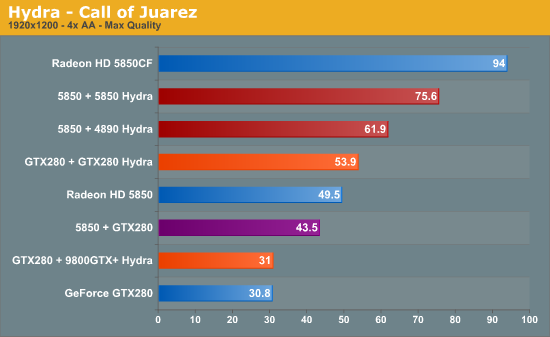
We’ll start with Call of Juarez, which is one of the Hydra’s better titles. With our 5850s in Crossfire, we get 94fps, which is just less than double the performance of a single 5850 (49.5). Right off the bat the Hydra takes a noticeable performance dive when using a pair of 5850s, splitting the difference between 1 and 2 cards with 75.6fps. Certainly it doesn’t look like Hydra can beat SLI/Crossfire, so it shouldn’t come as a surprise that Lucid and MSI aren’t claiming otherwise.
Moving to A-Mode with dissimilar video cards, we get some more definitive good news. Combining a 5850 and a 4890 gets us 61.9fps, a 25% performance improvement. This is less than the raw power of the 4890 (which is to say, in a perfect situation the 4890 performs at well more than 25% of a 5850) but it’s solid proof that this works.
As for the NVIDIA side, since we don’t have SLI results we’ll have to look at single-card and Hydra results. While 1 GTX280 gives us 30.8fps, a pair of them in N-Mode gives us 53.9, a 75% increase. This is much better than the increase we got on the 5850s, and much closer to the 100% theoretical max that we expect SLI is close to.
Switching to a GTX280 + 9800GTX+, things aren’t so rosy. The performance difference is practically absent at 0.2fps. While the Hydra technology scales worse the more mismatched a set of cards are, this is particularly awful.
Finally we have X-Mode using a 5850 + GTX280, with the AMD card as the master card. Here we get 43.5fps, which is slower than a single 5850. During this time we got significant microstuttering and striping in the image. Our best guess is that the Hydra was having trouble in the compositing phase, as the striping is a product of that. However in A-Mode and N-Mode we encountered no such issues. To the naked eye, Call of Juarez looked just as good in A-Mode and N-Mode as it does on a single video card.
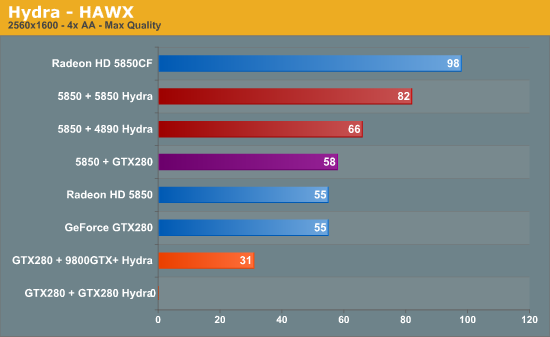
Moving to our old standby of HAWX, the picture is similar. Hydra performance on the 5850s is still below CF, but it’s still a 50% improvement. 5850 + 4890 is a 20% performance improvement. The GTX280s weren’t quite a success story however – HAWX crashed with a Lucid driver error when attempting to load the main menu of HAWX. Strangely the GTX280 + 9800GTX+ had no launch issues, rather the combination significantly underperformed the single GTX280 at -56%. Finally the 5850 + GTX280 came in at 58fps, which at a few fps faster than the lone 5850 is less than flattering.
Besides the single crash at no point did we see evidence of graphical corruption. HAWX always rendered correctly, even in X-Mode.
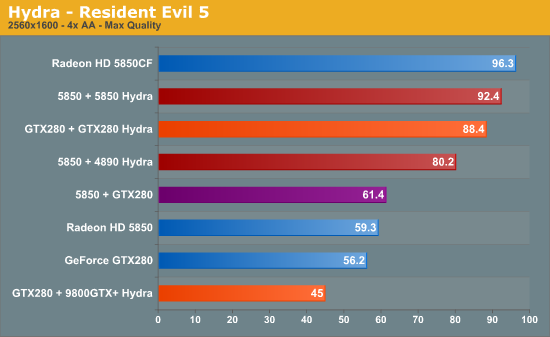
Resident Evil 5, in spite of being on the approved game list, was problematic for all Hydra modes. Every mode suffered from the same flickering problem (we suspect it’s lighting related), which doesn’t make the game unplayable but does make it annoying to play.
The performance however was very, very good. The 5850s got within 4% of CF mode, and the 5850 + 4890 still offered a solid 33% performance boost. The GTX280s did 57% better than a single GTX280, and the GTX280 + 9800GTX+ was the odd man out by losing performance. In X-Mode, the 5850 + GTX280 managed to squeak ahead of the single 5850 by 3.5%.
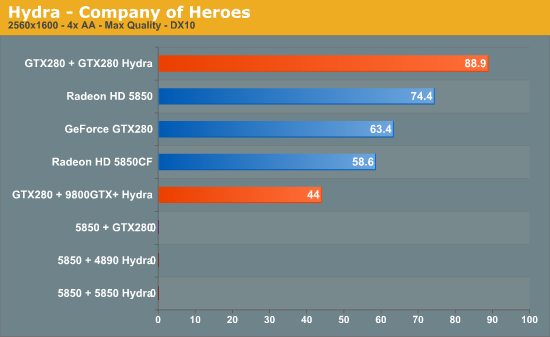
Company of Heroes is another game on the supported list that we didn’t have much luck with. There was no graphical corruption this time around, but instead it crashed on every mode involving an AMD card.
As for the NVIDIA cards, the GTX280s picked up about 30%, and the GTX280 + 9800GTX+ lost nearly the same 30%. There was no graphical corruption to report.
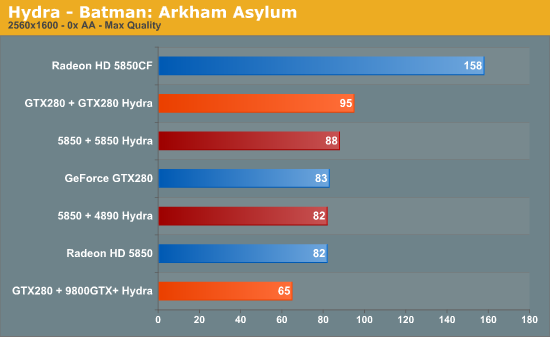
Finally we have Batman: Arkham Asylum, one of the most popular games of 2009. It doesn’t work in X-Mode, but does in N-Mode and A-Mode.
Unfortunately for the AMD cards, Lucid is having some scaling issues in A-Mode, something they do note in their release notes. A pair of 5850s is barely better than a single 5850, and a 5850 + 4890 flat-out isn’t better. The GTX280s pick up 15%, and the GTX280 + 9800GTX+ loses over 20%.
Frankly our testing experience was a mix of failures and successes, and this was sticking to the approved games list. Not a single game we picked to test worked perfectly in all cases, and the 1.4 driver release notes are a minefield of known issues. And unlike NVIDIA/AMD’s known issues, which tend to affect esoteric hardware and games, these are issues on what would be reasonably common high-end hardware configurations with popular games.
Here is by no means a complete list of games with known issues of graphical corruption: Call of Duty 4, World in Conflict (DX10), Rainbow Six Vegas 2, Operation Flashpoint Dragon Rising, Resident Evil 5. And as we’ve seen, this doesn’t include crashes, or undocumented graphical corruption.
We held off in doing significant testing on our Fuzion board until we had the 1.4 drivers in order to give Lucid time to get their next driver set out, since that set would be available when the hardware shipped. It was our hope in that moving from the 1.3 to 1.4 drivers that we’d see a reduction in graphical corruption compared to our tests in December when Lucid and MSI sent reps out, but that has not been the case.
This is by no means a complete list, and we aren’t going to claim otherwise. But in our testing thus-far, the Hydra drivers clearly need much more work. Frankly, we hesitate to think about what might have happened if the Fuzion shipped in November as originally announced.










47 Comments
View All Comments
cesthree - Friday, January 8, 2010 - link
Multi GPU gaming already suffers from drivers that suck. You want the < 3% who actually run multi GPU's to throw HYDRA driver issues into the mix? That doesn't sound appealing, at all, even if I had thousands to throw at the hardware.Fastest Single GPU. Nuff Said.
Although if Lucid can do this, then maybe ATI and Nvidia will get off their dead-bums and fix their drivers already.
Makaveli - Thursday, January 7, 2010 - link
The major fail is most of the post on this article, its very early silicon with beta drives. And most of you expect it to be beating Xfire and Sli by 30%. When the big guys have had years to tune their drives and they own the hardware. I would like to see where this by next christmas before I pass judgement. Just because you don't see it in front of your face doesn't mean the potential isn't there.Sometimes alittle faith will go along way.
prophet001 - Friday, January 8, 2010 - link
i agreeHardin - Thursday, January 7, 2010 - link
It's a shame the results don't look as promising as we had hoped. Maybe it's just early drivers issues. But it looks like it's too expensive and it's not any better than crossfire as it is. It doesn't even have dx 11 support yet and who knows when they will add it.Jovec - Thursday, January 7, 2010 - link
With these numbers, I wonder why they allowed them to be posted. They had to know they were getting much worse results with their chips than XF, and the negative publicity isn't going to do them any good. I suppose they didn't want to have another backroom showing, but that doesn't mean they should show at this stage.jnmfox - Thursday, January 7, 2010 - link
As has been stated the technology is unimpressive, hopefully they can get things fixed. I am just happy to see one of the best RTS ever made in the benchmarks again. CoH should always be part of anandtech's reviews, then I wouldn't need to go to other sites for video card reviews :P.IKeelU - Thursday, January 7, 2010 - link
I was actually hoping AMD would buy this tech and integrate it into their cards/chipsets. Or maybe Intel. As it stands, we have a small company, developing a supposedly GPU-agnostic "graphics helper" that is attempting to supplant what the big players are already doing with proprietary tech. They need support from mobo manufacturers and cooperation from GPU vendors (who have little incentive to help at the moment due to the desire to lock-in users to proprietary stuff). I really, really, want the Hydra to be a success, but the situation is a recipe for failure.nafhan - Friday, January 8, 2010 - link
That's the same thing I was thinking through the whole article. The market they are going after is small, very demanding, and completely dependent on other companies. The tech is good, but I have a hard time believing they will ever have the resources to implement it properly. Best case scenario (IMO): AMD buys them once they go bankrupt in a year or so, keeps all the engineers, and integrates the tech into their enthusiast NB/SB.krneki457 - Thursday, January 7, 2010 - link
Anand couldn't you use a gtx295 to get approximate gtx280 SLI figures? I read that Hydra doesn't work with dual GPU cards, but couldn't you disable Hydra? You mentioned in the article, that this is possible.As for technology itself, like a lot of comments already mentioned, I really don't see much use in it. Even if it worked properly it would have been more at home in low to mid range motherboards.
Ryan Smith - Thursday, January 7, 2010 - link
I'm going to be seriously looking at using hacked drivers to get SLI results. There are a few ways to add SLI to boards that don't officially support it.It's not the most scientific thing, but it may work to bend the rules this once.